Once upon a time, there lived a blind man in a village. One day his friend told him, “Hey, there is an elephant in the village today.”
The elephant had always been a mystery for him. The first time he heard about it was when he heard children puzzling each other: “How do you put an elephant into a fridge?”. He thought: “Well, just like we put food into it, isn’t it? Just open the door and put it inside, right? Whatever the elephant is, that’s the basic steps.” So he asked them:
– So what is the answer?
– You open the door, put it inside, then close the door.
– Wait, what? Isn’t that obvious? So what is so special?
– Because it’s large?
– But even if it’s large, then isn’t that still obvious?
– Yes, but it’s large, you know.
– …
He tried to ask more, but both he and the kids went circular. He knew that it was because he didn’t know what the elephant was, but explaining that the elephant was an animal with a trunk didn’t really satisfy him. Instead of having an answer to the elephant, now he had a new question about the trunk. The conversation went to the path leading nowhere, and the elephant was still a mystery for him.
* * *
The moment of solving this mystery had come. Touching the trunk, he thought: “Oh, it’s like a snake”. Touching the leg, he thought: “Oops, it’s more like a tree”. Touching the tusk, he surprised: “What? Now it’s like a spear?”. What an animal!
“I really don’t understand”, yelled the blind man. “Why can it be like a tree, like a snake, like a spear at the same time?” He tried his best to explain what he knew in detail, hoping that the non-blinds could explain it. But for them, it was his question so nonsense. They, no different than him, tried their best to explain the animal in detail, but no-one could give him a satisfactory answer. Suddenly, he realized that they were talking a language that he couldn’t understand. He wished he could have been able to see it for once, but it seemed that it was out of his sight forever. The animal, right in front of his hand, seemed out of his reach.

.
.
.
As the title suggests, this theory is an attempt to explain everything relates to the word “perspective”, such as: “keep a fresh perspective”, “look at the problem in a different perspective”, “different persons have different perspectives” or “try to understand the perspective of the other”. All of the advice is good, but it’s always easier said than done in practice. If there is theory to explain what exactly a perspective is, then we don’t need those advice anymore.
The theory is stemmed from two analogies in the preface of a small poem book, whose author has borderline personality disorder, and is a big fan of Zhuangzi, a Taoist philosopher. The applications will be:
- Analogy
- Writing
- Finding the balance point
- Communication and perspective taking
- The cold gaze
To be specific, here are the questions that each section trying to answer:
- Analogy: Why do analogies help us understand a problem we don’t understand? How to reason with analogy without making logical fallacy?
- Writing: How to explain a concept when the novice really lacks background? What does it mean to have a transformative writing? What does “big picture” really mean?
- Finding the balance point: Why are efforts to be adaptive become maladaptive? Why is it hard to balance between disciplinary and flexibility? How to stop the indecisiveness without worrying of doing wrong?
- Communication & perspective taking: Why do people keep misunderstand each other? Why do others keep distorting our words? Why don’t we realize that we are distorting theirs? How to solve it when it happens?
- The cold gaze: How to see your core value when your mind is clouded with fantasies, ruminations, resentments, or fears?
Each of them has been studied separately in different fields: cognitive linguistics, stylistics, decision making, communication & social psychology, and cognitive therapy. Their root, however, all origin from cognitive psychology, the study about how knowledge is organized and retrieved in our mind. There are researches to connect cognitive psychology to each field, but it doesn’t seem to have a research to gather all such connections in one place.
The underlying philosophies of it are Taoism, Buddhism, postmodernism, and perhaps romanticism. The discussion section will scramble a bit about the nature of information, metaphysics, epistemology, neurocognition, semantics, and physics. They are just minor points, and the readers don’t need to know any of them. The author doesn’t claim that they know too.
Because the writing section is quite long and scary, there will be a tea break after it. The tea break will discuss about logical naïve realism, intellectual betrayal, and fearlessness – everything that an independent researcher may face. The readers may want to grab some food or take a walk before continue. They may also want to avoid reading this article on phone too, because that would be terrible for their spines.
Sometimes a non-blind doesn’t aware that they are blind, and sometimes the blind can have a vision that the non-blind cannot understand. With this theory, I hope having a new perspective and taking the perspective of others when you need to do it most are no longer impossible.
The theory
Nomenclature:
- Clearness: a thing that you have no trouble in identifying, understanding and verbalizing it
- Fadedness: a connection that links two clearnesses in a movement, but they are subtle and you may be unable to pinpoint it, even though you know it’s there
- Movement: a complete line, or network, connects all the clearnesses in a perspective. A minimum movement has two clearnesses and one fadedness
- Perspective: a space where the movement forms and transforms. It directs our attention, attitude or emotion
Rules of perspective:
- Clearness and fadedness are the same, but whether it is clear or faded depends on the perspective. The fadedness can be revealed by slightly changing the perspective.
- Focus the attention at a clearness will bring us to a new perspective. If not, it’s an isolated clearness.
- Because there is a perspective inside each clearness, therefore the jump between perspectives are the fadedness between their respective clearnesses.
The relationship between clearness and perspective is called duality. It can be imagined as a zoom in – zoom out mechanism, like fractal, but it’s for convenience rather than correct.
Rules of movement:
- When a new movement is formed, it will give born to a new clearness
- The movement that gives born to a clearness can be changed by time
Rules of emotion:
- When there is an unconnected clearness, you will have a dissonance. If the clearnesses are connected or new perspective is found, then you will have the opposite emotion of dissonance: resonance.
* * *
At first, maybe long, round, and animal are the clearnesses the blind man see. These clearness uniquely exist in the movement named snake, so even when there is no venomous, they still connect. Once the movement is formed, the perspective resets and snake is a new clearness. The same thing happens with tree and spear.

But there is no movement that has these three clearnesses that he knows beforehand, so now he is confused. New clearness must be added more to make a whole new movement, but until these first clearnesses are connected his confusion won’t stop. This only changes when the turning points show up:

These turning points by themselves are just ordinary clearnesses, but in this particular perspective they happen to be… the turning points. They can be suggested from other unrelated activities. They may be forgotten quickly from working memory, but we can recall them back. On the other hand, the non-turning point clearnesses are subjected to be erased quickly if they are isolated.
Together he will see:
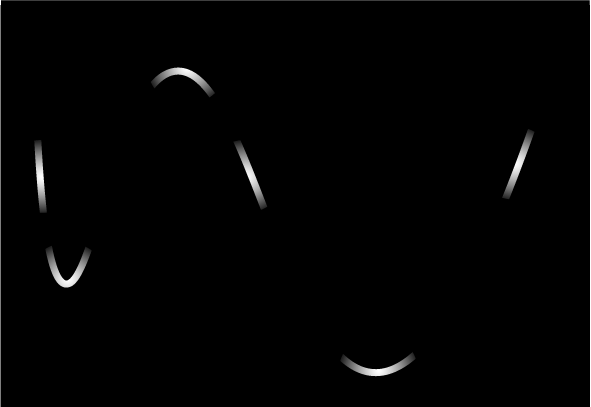
There are still isolated clearnesses, but now he can see the fadedness between nearby clearnesses. To put it in another way, to make a clearness no longer isolated, there must be a fadedness around it.
With this success, he can gradually complete it:

Finally there is no isolated clearness left. All are connected into a movement, and the clearness elephant is born. His definition will be something relates to tree and snake, and when those clearnesses uniquely appear in another perspective, elephant will be called out too. Watching how the meaning flipping is interesting and gives us the sense of rigorousness.
Once the movement is completed, the perspective is changed, and the movement is reset. After the reset, some clearnesses are relocated, some disappears, some are new. elephant won’t disappear once it’s registered, but the movement “inside” it tends to shrink to minimal, and may not contain tree or snake anymore. The likelihood that tree will stay largely depends on whether there is elephant or not in the tree movement.
Now he can understand a discussion about the extinction of mammoth, and is ready to adopt the rigorousness from Wikipedia:
Elephants are large mammals of the family Elephantidae and the order Proboscidea.
Applications
Analogy
Suppose you are a white who knows that your prejudice towards black people is unreasonable, but you don’t know how to solve it. Or you are a black who knows that your white boss is just harsh on you because of the work, not because they have prejudice on skin color. In any case, what would you do to solve this prejudice or insecurity, once and for all?
If you can take for grant the equality of the continents Africa and Europe, you can use it to form the equality in race. Your strategy here is to change the perspective from [Race] to [Geography]:
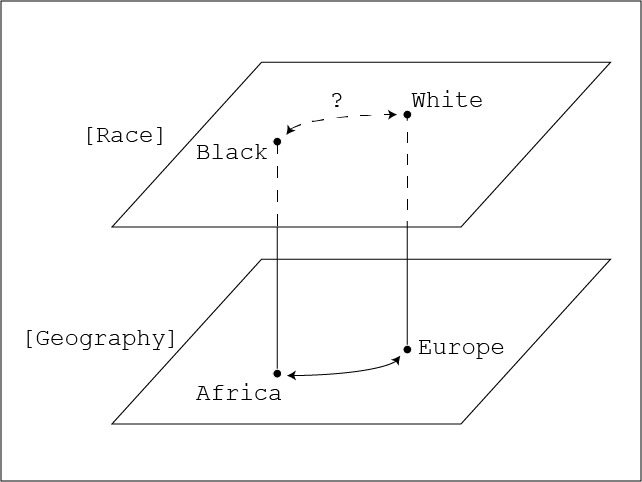
In the new perspective, you are free from your emotion. You don’t have to worry about having fear, bias, heuristics, memory distortions, etc. Africa cannot hurt your pride; Europe cannot enslave you. Your mind is sharp and rational in this perspective.
So by exploring the relationship between the two continents as if you are a geographer, suddenly a wealthy material to prime race equality back to the [race] perspective is available in your hand. The drawback, of course, is that to have the perspective of a geographer you should study geography seriously. But the results are worth the effort: you will feel something miracle every time you re-read your sentence.
Unfortunately I don’t have a decent knowledge on geography to illustrate this. But here is my take on the analogy between anger and turbulent flow, using as a closing words for an article about borderline personality disorder:
When a smoke begins to smolder, it first maintains its stability. But with just a little turbulence, the smoke becomes an uncontrollable chaos. Swirling currents will be generated to radiate heat outwardly, rolling together and causing more and more energy to be lost. And after the energy is completely depleted, it will dissolve into the surroundings and leave not even a single mark behind.

Superficially, that prose is about a physical phenomenon only, with physics jargon like stability, turbulent, chaos, current, heat, energy. But this is an analogy for non-physicists; the readers don’t need to understand what they mean. So in their perspective, what does this look like?
When a ______ begins to ______ , it first maintains its ______.
These gaps must be filled to make sense of the world; unconsciously the readers will projected themselves into it; what is filled depend on their background. For example:
When my mom begins her anger, she first maintains her calm.
In other words, the readers see themselves in there.
This very theory is built with this mindset:
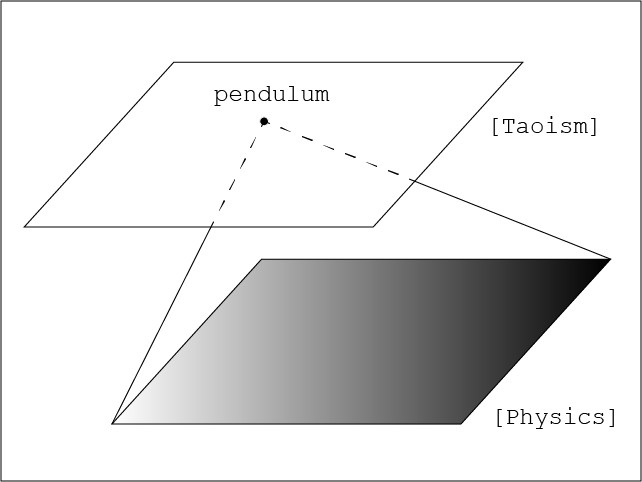
But there are many physical characteristics a pendulum has (wave, Fourier transform, chaotic movement, etc), and it took me a while to realize the feature being compared with is its visual display, and that is what we should focus on. The visual display comes from its velocity, and one cannot study the pendulum’s velocity without using complex number. This brings me to another perspective:
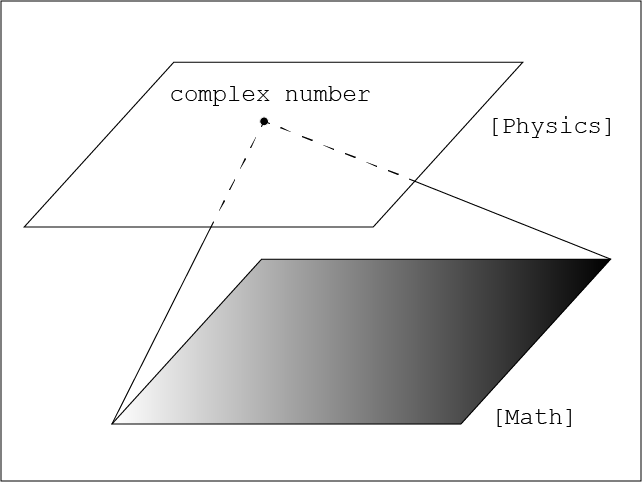
This is how I found the Riemann sphere, and by that, understood the moon analogy.
Pendulum and complex number are faded in [Taoism] and [physics] perspectives, because although they are necessary at the moment they come up, they are mentioned fleetingly in the context. When the authors have something else occupying their minds, then these concepts are just the tools, not the goals. They don’t think about them as how they really are, and they are not mindful in what they say.
When would analogy reasoning lead to fallacy, and when would it be the fuel and fire for thinking? Take a look at the watchmaker analogy:
- The universe is like a watch.
- A watch must have a watchmaker.
- The universe, being like a watch, must have a maker/designer.
Step 1 and 2 are fine, but step 3 indicates that the analogy-maker hasn’t escaped the [universe] perspective, and only find a way to justify their existing conclusion. Because of that, although step 2 is not wrong, it’s a way to cherrypick the data. If it were me, after coming up the first step, I would find a watchmaker and ask: “why do you love making watches?” His answer would be the perfect closing words for my essay about universe.
Consider another analogy:
- Life is like walking in the mist
- But to walk in the mist you just need to turn the light on. If you don’t have the light, just be careful in every step and you should be fine.
- Therefore in life you just need to be confident, be careful, and you will pass over it.
This time, the analogy makes more sense because the step 3 lifts a huge burden from the analogy maker. So while a logician would recoil in horror when hearing an analogy, a therapist would see it as a light house guiding the patient getting out of their learned helplessness. Because ultimately analogy is a way to cherrypick data, the validity of an analogy is not on its logicality, but on its ability to make the someone relieved. This is both subjective and objective at the same time.
So I think there are three questions to check before relying on analogy reasoning:
- Is step 1 made from a cognitive dissonance in an attempt to capture the reality? Or is it just for fun? (A kind of fanfic shipping)
- Is step 2 made from experts of the field (the geographer, the watchmaker, the professional mist-walker)?
- Does step 3 lift that burden from the analogy-maker? Have they checked many times that there is no impulse to draw such conclusion?
In other words, would the analogy make you feel like having a fresh perspective to solve a hard problem? If yes, then congratulation, the analogy is concrete.
Analogies that are common and stable in the culture indicate that they satisfy the last requirement. A large part of them can be found in idioms and mysticism, especially nature mysticism. Dreams can also be such source, because, you know, the mind is like an iceberg.
Writing
Science goes up by refuting it. After a thesis is proposed, an antithesis will come up, and then they combine together in a dialectical process to produce a synthesis. When this synthesis is registered in the memory of an expert, it becomes a thesis, and the dialectical process is not worth to remember anymore. It is not completely forgotten, but they become history. The expert, therefore, forgets how she becomes to be.
When she explains the concept to a novice, that synthesis is the only thing she can pull out from her memory. It is ordered and structured with a dozen more syntheses, and that network can be pulled out any time if anyone asks, reflected in the structure of any textbook. But that network is overwhelming for the novice. He doesn’t have the necessary background to follow what she says, and doesn’t have enough syntheses to understand the rest of them.
Let’s say the expert wants to explain that elephants are large mammals of the family Elephantidae and the order Proboscidea. Where should she start? The knowledge gap is too much, trying to explain any term is like going to the rabbit hole. But if she remembers how she was once a novice like him, then she will remember the struggle she had had to learn the knowledge. She will remember that for each synthesis in her memory it has a dialectical process behinds, and she will realize that what he needs is not the web of syntheses that she has, but the experience of such processes that make each synthesis worth to remember.
The experience of the dialectical process is not a comfortable feeling. Having to combine two contradictory ideas together creates dissonance and stress. She had to pay full attention to solve it, and being able to overcome it is why she is regarded as expert. People pay money for her because they don’t have time to experience those processes – they are busy to experience other processes.
The expert gets into a dilemma: the novice needs to experience the dialectical process to fully appreciate the synthesis, but whatever she can draw from her memory – whether it is a thesis, an antithesis, a synthesis or a name of the dialectical process – is not a dialectical process. But if it isn’t from her memory, then from where? In other words, the expert is damned if she does and damned if she doesn’t.
But if she takes a walk for 15 minutes, she will realize that it’s better to not try to define the concept and defer it to the end of the explanation. Because synthesis is the output not the input, the explanation should be closed with “…is the elephant”, not started with “the elephant is…”. In other words, she has to stop thinking about the elephant in order to explain it.
The sentence will now change from
Elephants are large mammals of the family Elephantidae and the order Proboscidea
to
When a large mammal is in the family Elephantidae and the order Proboscidea, it is an elephant
Suddenly the strategy is clear. To explain elephant, she has to forget it and focus on mammal first, then modify its meaning. If he hasn’t known what mammal is, then she just needs to reapply the strategy to it. Because he has experienced the process, so even when he doesn’t know what mammal is, he will still get that elephants are large mammals of Elephantidae and Proboscidea. I guess transforming an unknown object to another unknown object is easier than trying to imagine an unknown object having various unknown features.
By moving the concept to be explained to the end of the sentence, the definition will become a mini story. The subject of the sentence becomes a character who faces a problem, and then later on beats it with an abstract concept. The reader will have a stress and a climax, and the explanation will be stressful and relieving at the same time. He will get the definition even when she doesn’t use it.
When the reader has a stress, his brain alarms that there is something wrong with his life, and an intrinsic incentive to find the solution will come up. He will pay more attention than usual, making meta phrases like “the main point is” or “it’s important to note that” unnecessary. When the solution is his solution (not the author’s), then a synthesis will be registered in his memory.
With a psychological stress placed at the beginning of the explanation, the author will enter the story mode. In this mode, the writing will be a story itself, and she doesn’t need to find other stories and examples to illustrate it. Many rhetorical devices will be used, but the aim is not to stimulate the readers, but to form concept from “the void”. Every analogy, figure of speech, stylistic device, etc. is not embellishment, but a way to reduce the stresses from the induced stresses. It’s less about coupling the jargon with flowery words or jokes, which only have situational effects, and more about weaving them into memory. The ideas aren’t simplified, but are primed and uncovered later on.
When the writing is playful and stressful at the same time, each sentence will sound authoritative and absolute. But because it always introduce new antitheses, corrections can always be added in the next sentence. This style will make the reader feel like the author knows what she is talking about, even though he really lacks the background to follow it. But if her intention is not to trick him, then it will be one of the hardest challenges she will ever make.
Although swapping the structure of a sentence seems easy, seriously doing this for a whole writing is not, because the writer has to reorganize her schema and make the body of knowledge become a story. For the reader, being continuously stressed and then relieved is no difference to torture, because the art of torturing is to make the victim live in an endless pain.
The sentence
For the reader, being continuously stressed and then relieved is no difference to torture, because the art of torturing is to make the victim live in an endless pain.
is a way I torture you. The word ‘torture’ is scary and unexpected – it absorbs a lot of your energy to make sense of it. But I don’t stop yet, but keep applying pressure by explaining the word, forcing you to spend even more energy after the comma. It’s like I’m pushing your head into the water; the more you fight the more I push. But when you are about to faint, I pull you out of the water to let you feel the fresh air in a new paragraph.
In order to feel what the readers feel, I had to torture myself tenfold. After that idea came up, I just wanted to have a deep sleep. But I couldn’t. I lay in bed, feeling my energy was draining out from my body, but my brain didn’t stop. New ideas still came like flood, demanding me to grab the phone to note them down, even though I couldn’t lift a finger. For the rest of the day, I just wanted to lying around doing nothing. In the next two or three days it seemed that I was back to normal, then suddenly in the following day I just didn’t want to do anything again. It took me a week to fully recover.
I don’t think there exists a torturer who want to find every way to help his victims out of trouble.
* * *
Let’s rewrite this section.
When the expert says “the elephant is…”, she accesses the [elephant] perspective and find a movement in there to complete the sentence. Each clearness in there is a door to access other perspectives:

Because there is no clearness elephant in the [elephant] perspective, all the expert knows is that understanding elephants is so easy, but she can’t pinpoint exactly why she gets that confidence. She has to escape it and find a perspective where elephant lives in, so that she can make it a synthesis. Preferably that perspective should be familiar with the novice, and this requires her to acquire a lot of perspectives. This is hard, but this is doable.
Usually, a single sentence cannot explain anything. She has to build background from “the void”, and the best way to do this is via priming. If the jargon has an everyday meaning that he can understand, or can be convert to verb or adjective form, she can use that to develop a new, specialized sense. For example:
If from childhood the child tend to avoid confronting…. This avoidance will …
Because the topic in the second sentence (avoidance) is primed, the reader will feel that it’s a natural development. But because it is different to the topic of the first one (childhood), so he will feel a little difference. The combination of both will provoke his curiosity, making him going from one perspective to another, rather leveling up in an endless ladder of knowledge.
The same can be applied with larger units in the article, be it sentences or paragraphs. As long as the start of the next unit is an elaboration of an implicit understanding of the previous one, then a fadedness will be unfaded and become a clearness. But because this clearness – now plays the perspective role – is different to the previous perspective, then we have a jump between them. This will make him not feel lost when the topic is changed suddenly, but make her and her colleagues not feel bored when reading a thing they already know. The perspective is transforming.
Let’s take another example. Let’s say she wants to explain potential energy:
Potential energy is the energy possessed by an object because of its position relative to other objects. (Wikipedia)
This time, rather than converting the definition into a dialectical movement, we can use priming instead:
When an apple suddenly appear in the middle of the space, it immediately has a potential, a relative distance between it and the Earth.
The jargon potential is presented as if it is a synonym of relative distance, because relative distance is crucial to understand potential. But what is actually happening here is that other features of the jargon are primed within the context (as an intrinsic property, of the apple, in the relationship, with the Earth), so when those fadednesses are unfaded, his understanding on the jargon will be refined unconsciously. In other words, the definition is sprout out throughout the text.
Because his working memory can only hold up to 4 clearnesses at one time, she has to pick a most important keyword to associate it with the jargon, and leave others primed within other words that he can understand. This makes any description can only be a slice, a cross section, a… perspective to the object, and she has to constantly change it to help him understand it fully. Depending on the mood, a person in low mood can feel the perspective change drags them out of trouble, and a person in high mood can feel trouble is dragged into them.
So far we have discussed two stylistic devices that can be explained with this theory: synthesis and priming. There is another one, parallelism, which is better explained in the section Finding the balance point. So in summary we have:
- Synthesis: the perspective is a clearness produced by the dialectical movement in the previous one
- Priming: the fadedness is embedded and brought up later
- Parallelism: each mapping between two perspectives is itself a perspective
So word after word, and sentence after sentence, the readers are brought from one perspective to another. Each clearness activates a previous memory, and the whole movement becomes a perfect combination of words. It is this perfect combination of words that both he and she are chasing after, but the way this combination represents is different to each person. This sentence is in a different perspective to the previous ones, but overall they are both clearnesses in this paragraph.
Tea break
The topics below build backgrounds for the next sections, but they don’t directly use the theory. They are stories to be told in tea breaks.
1
There are many advice and philosophies that advocate refuting the perceived phenomena, for example:
- Taoism & Buddhism: the bad equals the good; there is no need to be scared of the bad
- Science: before proving it right you must prove it wrong first; everything can be, and should be, explained.
- Evolution: being hurt is an opportunity to mature and become flexible
- Skepticism: there is nothing we can be sure of
- Postmodernism: talking about meaning is meaningless; everything is just a language game
Under the right conditions and personalities, they may add unnecessary tensions to interpersonal relationships, and become maladaptive thoughts. For examples, the person may:
- Constantly “misunderstand” others to help them appreciate the opposite, or wonder about a thing one knows that one knows very well to encourage their curiosity
- Feel guilty for doing the urgent thing when a solid understanding of the subject isn’t acquired yet
- Deliberately worsen a bad situation in order to learn something new, or hiding important information to test their flexibility and intelligence
- Do silly things to test whether one will regret for doing in future or not
- Use synonyms with bad connotation to describe a good thing (and then feel guilty for being “evil”)
There should be a study on how schools of philosophy interact with personalities, because sometimes the desire to be flexible and adaptive may be inflexible and maladaptive, not because you have unfortunate life events in your childhood. It’s still basic cognitive therapy, but the core beliefs/automatic thoughts can be so complex that it would take a lot of time and money to pay for a therapist to find out; and usually they can’t understand it anyway. Wanting to capture the ultimate truth should help us form and maintain healthy relationships, not exclude them.
It makes effort to help harder, since the receiver will always feel that they are doing the exact thing being advised.
2
In social psychology, naïve realism is the human tendency to believe that we see the world around us objectively, and that people who disagree with us must be uninformed, irrational, or biased. It is considered as one of the four major insights in the field.
The three tenets that make up a naïve realist:
- Believe that they see the world objectively and without bias.
- Expect that others will come to the same conclusions, so long as they are exposed to the same information and interpret it in a rational manner.
- Assume that others who do not share the same views must be ignorant, irrational, or biased.
The last two tenets are the necessarily results of following logic. The question is: would the first one is too?
In my understanding, logic only studies the relationship between statements, not the truth value of the premise. For example, if we have a deduction:
All men are motorbikes.
Socrates is a man.
Therefore, Socrates is a motorbike.
Then logic only confirms whether the conclusion fits the premises. Even if the premises are made by scientific methods, then a logician will still assume that there is a small chance that they are wrong. (“Logician” here means a person who respects and follows logic in general, not necessarily someone working in the field of logic.)
However, if they has checked and tested the premise many times, then they have to believe that their action to see the world is objectively and without bias. This is more true in the case that logician acknowledges their human biases and distortions, and has done everything in their best to check that. The belief that they are objective and the belief that they may be wrong aren’t mutually exclusive. That belief, therefore, is a necessary consequence of believing in logic.
To put it in another way, there are 3 additional arguments in parallel with the specific problem the logician has to deal with:
- A: They follow the laws of logic
- B: They know that they may be wrong
- C: They are objective and has no bias
I think A is sufficient to conclude C (in fact it may be that A ⇔ C). B is an additional filter to make sure (a) A actually exists, (b) the premises of the specific problem are correct, and (c) no implicit premise is missing. But at the same time it makes the logician less confident at the moment they need to be. B makes A believable and makes C unbelievable, even though A and C are the same.
3
When an independent researcher thinks that they have a revolutionary idea, they face two questions: how to articulate the idea in an organized fashion, and how to make sure that they are correct. They are aware of their situation: for one revolutionary idea there are thousand pseudo-revolutionary ones, and there is basically no way for the contemporaries to differentiate them. Sooner or later, they will be classified as crank.
Because negative emotions get priority processing in the brain, the skepticism will always be overwhelming in the reviewer’s mind, making them cannot read the researcher’s idea and responses as how they really are. Always, always, the reviewers will find a new hole to attack. In their eyes, they are helping the researcher to see the holes in their logic, but in the researcher’s eyes, they are avoiding the counter-evidence.
On one hand, the criticism is correct. When the idea is so convoluted and has many holes and many wrongs, to the point that even its author cannot fully convince themselves yet, then no one could be convinced. But on another hand, it’s evident that the reviewers dismiss or distort the ideas, and violate the core value of science: respect the person, critique the idea. Although most of them just don’t understand what the researcher says and have to find a label to justify it, some of them are overtly hostile, not just making humors with no intention to offend. Trying to cover for them is a lie the researcher punches in their own face.
The researcher is disappointed, because all the good values that they have assumed and expected in the reviewer are collapsed: objective, non-bias, curious, open-minded. At first they will still try to cover for the personal attack, hoping that it’s just a misunderstanding, because such a basic fallacy cannot exist in a person who call themselves as a researcher. But in the reviewer’s eyes they are just spamming and stalking, and any evidence that they are not crank will be read without enough care. Despite the emotional investment to communicate, a satisfactory answer will never arrive.
Yes, Darwin was denied before appreciated, but who cares? Who cares about fame or recognition, they just want to verbalize what they see. Yet the reviewers insist that they are arrogant, attention seeking, bias, high, etc. They knew ahead that the prejudice will come, but all the efforts to satisfy them are dismissed. The more they work hard to keep that from happening, the more likely they get it. The self-fulfilling prophecy is completed.
When the trust is finally broken, then psychologically speaking, this is betrayal. Because memories of the constructive feedback will activate the negative ones too, we can merge all reviewers into a generalized one, although technically they are different people with different personalities. This generalized reviewer betrays the trust that they are rational, yet at the same time supports them to see the holes in their reasoning. This act of betraying in an effort to help, I will call it intellectual betrayal.
Because the situation is now reduced to the interaction of two persons, I’ll refer to the researcher as “he” and the reviewer as “she”.
Like any kind of betrayal, it creates resentment. Resentment is a kind of self-punishment: its evolutionary purpose is to protect the self from future hurts. The brain keeps thinking about the outcome that should have happened, be unable to forgive itself for the mistake it was unable to do anything better. It doesn’t consider the fact that it is impossible at that moment; it only cares that we could have done it differently. In the case of intellectual betrayal, it’s a perfect response that should have been answered to hostile comments. It keeps punishing itself, wishing for another chance to re-answer it.
Generally, in any type of conversation, both sides instinctly know that they are just seeking for perfect combination of words. This is especially true for people who refuse to be open-minded. If a founder of a startup wants to catch the attention of a future investor, they only have 15 seconds to deliver their elevator pitch. If a naïve realist cannot reach a consensus with another naïve realist, both will have a little dissatisfaction for unable to put the finger on the thing they can’t agree with. To satisfy her, he has to dig into what she said, carefully analyze it, see what she wants to hear most, burrowed in the negative words.
So we get to a funny situation: the act of solving the resentment prolonging it, and only by prolonging it that he can find important information to create the values she is looking for. The more he resents at her the more values he creates, and the more she violates her core values the more they are protected. Unlike normal betrayal, in which the betrayed person has to draw boundaries and gain control over the betrayer, this time she deserves to be pleased, and only when she are pleased the betrayal can finally stop. He knows he will be betrayed at the beginning, but still continues to trust her because he believes the truth will win through.
Therefore, he will oscillate between “nah, I can do it” and “why does this happen to me? I did nothing wrong”. Because the chance to present it to her has been closed, he will resent. But because all of these things has no relation to the actual research, he doesn’t feel afraid to face it. (She too will oscillate between “what kind of smoke did you use” and “oh boy this is so sad”.)
And as if the situation is not bad enough, our memory makes it worse. After the perfect answer is found, our attention is switched to other important things, and so when it’s time to use the perfect answer in a new occasion, we forgets. What is left is a mix between the confidence for having solved it and the frustration for can’t remember it and don’t know why we can’t remember it. You may also have a dissatisfaction for having to accept an alternative answer just because it’s available at hand, not because it truly convinces you. And not only we may be unable to recall the thing we know very well when being asked suddenly, under stress we can forget as well. So the frustration of not remembering it can itself be a reason for not remembering it. Getting into a vicious cycle is never feel easy.
The problem can only disappear when he reaches the last stage of the research, when all fragmented, isolated ideas are connected. But it will take months or years to finish, and until then resentment can still pop up from nowhere. If the researcher still cannot convince himself, then he will still have some dissatisfaction when articulating it. The idea will still be confusing, and sooner or later the reviewer will misunderstand it.
The idea that the elephant is a combination of snake, spear and tree would be regarded as a crackpottery theory to a zoology. This will make the blind feel anxiety, because generally he doesn’t have the coping skills to deal with that. But if he has a determination to use logic, then ultimately the perfect combination of words will be found, and this will make him become fearless.
4
Let’s rewrite the previous section.
A fearless person will have to face infinite skepticism that they are wrong or arrogant. No need to make such comments: this fearless person has already feared that they are wrong or arrogant. Fears will come when we are aware that we are fearless. But the problem of distrust is the easiest thing to solve: one just needs to find a perfect combination of words and everyone will be satisfied. This can be captured by logic, and this is what makes the person become fearless.
On the journey to that perfect combination of words, the fearless person has to face these feelings:
- The guilt of claiming that his work is revolutionary, and the fantasy that he will be famous
- The resentment from hostile comments and dismissions
- The rumination of being unable to answer the skepticism earlier and satisfying
- The loneliness of seeing the people who want to support can’t understand, and the ones who can understand can’t spend time to support
- The tip of the tongue or mental block under stress
Until the perfect combination of words is found out, those problems won’t go away. And by definition, at the early stage of any idea there is no way to remotely describe what he sees. And if he can describe it to himself, then it would be totally absurd to her. All he know is that he can do it.
There are many signs that he is on the right track: she believes he can do it, and he totally encourages her to have skepticism on him. What he can’t understand is why she has to be astonishingly surprised and shuts down all of her willingness to listen. He just can’t. What he sees is that his words, written or spoken black and white, can somehow be distorted, and he has to argue with the obvious things. From the bottom of his heart, he just wants to say: “huh?”
It is reasonable to describe the her reactions as bipolar, where trust and distrust happen at the same time. “I really want to support you, but this is so crazy”. But whatever her emotion is, he has to work on his first. To stop the guilt of being arrogant or attention-seeking, he needs to prove to himself that his nature are not like that. It requires a huge courage to accept that he is wrong, but when he already fears that he is wrong, then it also requires no less courage to accept that he is right.
As long as she still has a skepticism on him, her concerns are just… off-topic. Instead of telling him he is wrong, her advice only confirms that he is on the right track. Because in his eyes she has already solved her worries without him, his mind is too quick to focus on other important topics and forgets that he has to assure her that he is on the right track. When he is 99% sure that step 1 is correct, then he can’t allow him to be confident. But when he can be sure 100%, then the only thing his mind could think about is step 2, 3, 4, 5. As the result, he can’t remember why his belief is so strong. What is left is a mix between confidence, frustration and dissatisfaction.
He has to take the lead in this conversation. Under the skepticism that it is impossible, he has to say:
Nah, it’s easy. It’s actually possible. I can do it.
If he just says that he thinks his plan will work, then it’s him to feel unsure how it would work in each step, and no one will believe in his logic. But if it’s easy, then it’s a different attitude. It says: there are other things that is more important than that. He has to stop distorting her words, even though he always feel they are talking at the same thing.
For the skepticism that he is wrong, he has to readdress the worries in a different way, so that he can force himself to stop dismissing her feelings, and show her that there are more than one way to solve her worries. Ideally he may want to have a systematic understanding on logical fallacies and cognitive biases, so that not only he can answer his self-doubts, but also can help her express her doubts more succinct. If she can’t help him verbalize his fears, and he can’t help her verbalize her fears, then this is not only a blind leading a blind, but also a fight of the blinds. Or to put it like Yoda, “named must your fear be before banish it you can”.
This is what a fearless person should prepare before starting any project.
5
I think it’s so easy to become a buddha: one just needs to have a determination to become a good person. Anyone can do it. The teaching of the Buddha is to solve the sufferings a good person may have in their life, so that that determination is not eroded. If you ever feel like constantly walking in the mist and don’t know what you want to do, how about trying to become a good person? It will give you a sense of what you want to improve, appreciate, protect and connect with.
Being right also seems to be easier than being wrong: one just needs to have a determination to stay with logic. Anyone can do it. By then you can feel the fun of facing your own wrong. And when it’s fun to see how you are wrong, then basically you fear nothing.
Of course I know that it’s easier said than done, but the idea needs to be packed that way so that you can fake it until you make it.
Finding the balance point
Is using phone in a meeting distracting and disrespecting the speaker, or is it because each person has a right to focus on what’s more important? Shouldn’t the speaker focus on the talk, and doesn’t the listener come there to listen? There are endless arguments like this, and both sides have their rationales. If we keep thinking about what to do or asking whether we are wrong or not we may have analysis paralysis. The perfect is the enemy of the good.
Yet, for every proverb there is an opposite one, and at the end of the day, it seems that we have to agree to disagree. But even so, that conclusion can be criticized as a thought-terminating cliché, and it is so frustrating, because for every conclusion you make, you are damned if you do and you are damned if you don’t. When even saying something as a thought-terminating cliché is also possibly be criticized as a thought-terminating cliché, then it seems that we have to compromise logic and stability for flexibility and adaptation. You just can’t be flexible and commit to something at the same time, and I think this is the difference between Western and Eastern traditions.
The dissatisfaction that one may have with pop psychology is that it just gives little more than platitudes or oversimplified and contradictory advice. The same thing can be said to Eastern philosophies, because it’s really hard to tell if ones misconstrues the teachings or not. The texts make sense, but they aren’t fully satisfied. Something is unfulfilled, but we cannot pinpoint exactly what. There will be holes to attack, and when they are attacked, the attackers show their holes.
Here is my unexhausted list for proverbs or advice for the disciplined – flexible issue:
| Disciplined | Flexible |
| Consensus is the building block to success | Let’s agree to disagree |
| Half-baked understanding does more harm than good | Perfect is the enemy of good |
| Don’t reinvent the wheel | Don’t follow the crowd |
| Proverbs speak louder than words | For every proverb there is an opposite one |
| No pain no gain | Only do it when it make you feel happy |
| Don’t jump to conclusion | Relax! Don’t think too much |
| The early bird gets the worm | The second mouse gets the cheese |
This is funny, because the efforts to against maladaptive thoughts can become maladaptive, similarly to how syntheses become theses once registered into memory. (I think this phenomenon strongly relates to polysemy and the nature of information, but this will be discussed later.)
The secret to be flexible without having to compromise stability (e.g. violate rules) is to notice the struggle of others, because mitigating others’ struggles is the reason why stability is born at the first place. Instead of worrying whether a behavior is moral or legal or not, we should check its ability to reduces the cognitive dissonances of everyone in long term. In the case of having conflicts, no one will feel that they have to compromise, but sees how their worry is maximally satisfied before it is actually satisfied.
Because perhaps all exploitations attack on the flexibility of the victims, so when we can stop worrying whether our decision is inflexible or not, then we can be confident to stay firm and thus not afraid of being exploited. When we are not afraid of being maladaptive, then we don’t need to subscribe to maladaptive thoughts.
* * *
Let’s rewrite this section.
In the debate whether one should devote time to learn Go or chess, it seems that Go is clearly superior. The Go community actually gives reasons why Go is better (more flexible on these aspects, more disciplined on those aspects), while the chess community only discusses what is more fun (note that in both threads there are users who actually play both games). But if we watch some pro chess games and completely immerse into its rules and tactics, we can gradually realize the fun of it that Go don’t have, or we know of but don’t realize how impacting it is. In other words, when we explore the perspectives of the clearnesses in the [chess] perspective, our judgement will disappear.
When there are two things that make us undecidable, or when we sense that our decisions contain prejudices, instead viewing them as clearnesses we should look into their dual perspectives and see the clearnesses inside that:
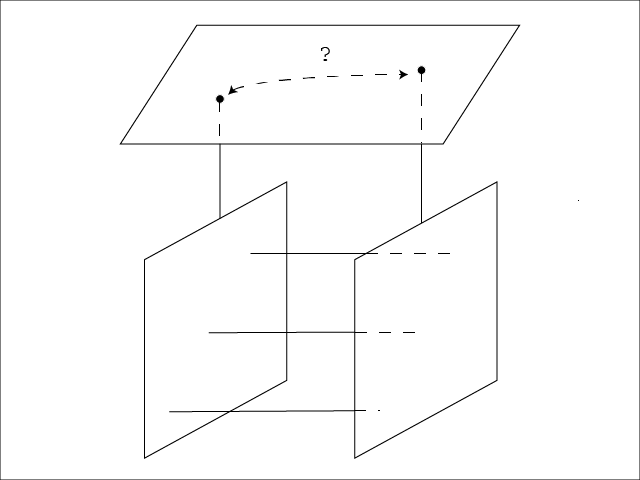
Therefore after elaborating why one should choose this but not that, the decision maker should sit down and make a comparison table. (The official name is the decisional balance sheet.) This will force them to roll their sleeve to compare individual features, instead of making superfluously judgement. This can apply to any debate, be it paper books vs phones, preservation vs development, Western vs Eastern, or tree vs snake.
Each mapping is a movement, connecting two clearnesses from two vertical perspectives in a horizontal perspective. With this sketch we can say that the jump between two perspectives is a collection of fadednesses. The mapping should be done after both perspectives are properly constructed, or else the preexisting opinions will still be there, and the old perspective cannot be escaped. Half-baked understanding does more harm than good.
Each of them can become a sentence, paralleling to each other’s. If the reader doesn’t have previous understanding on each perspectives, then they will feel the sentences are unconnected. The points don’t seem to connect, even though each individual one can be understood.
If Western philosophy is more about logic and concreteness, and Eastern philosophy is more about spontaneity and transcendence, then this can be a framework to justify that. The vertical mapping is about exploring a whole different perspective from individual clearness, and the horizontal mapping is about transforming what is just explored.
Communication & perspective-taking
When two persons really really want to communicate to each other, it’s not that they don’t want to put themselves in the other’s perspective, but because whatever one says it will be distorted in the other’s ears. If it’s not distorted, then they don’t have to really really want at the first place.
Let’s say we have a conversation:
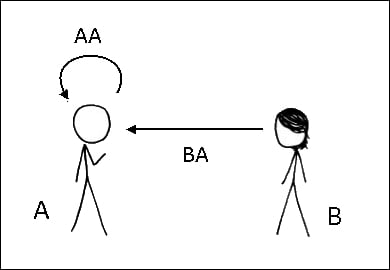
When Cueball talks, every word he says is a clearness, with pre-existing fadenesses helping him jumping from one clearness to a next one, and in each clearness there is a whole perspective that he can access easily. But for Megan, she may:
- Have different perspective inside each clearness
- Have clearnesses in her perspective (BA) that don’t exist in Cueball’s perspective (AA)
- Not have the pre-existing fadenesses of Cueball
So even when there are clearnesses that both agree with, it’s very likely for misunderstanding to happen. We say their perspectives are distorted from each other:
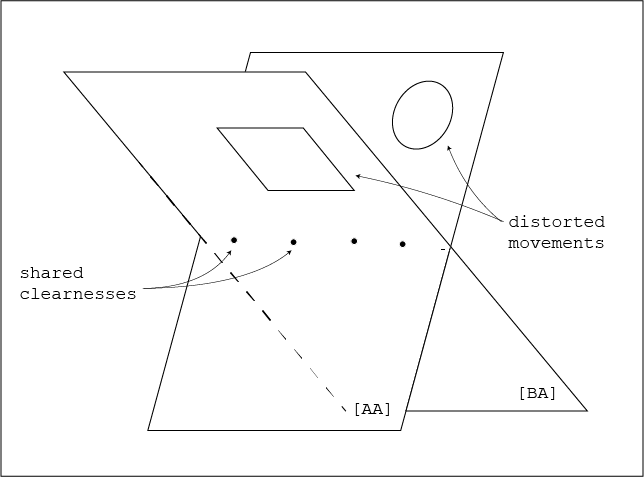
Therefore, each of them has a distorted zone and a non-distorted zone (or common ground):
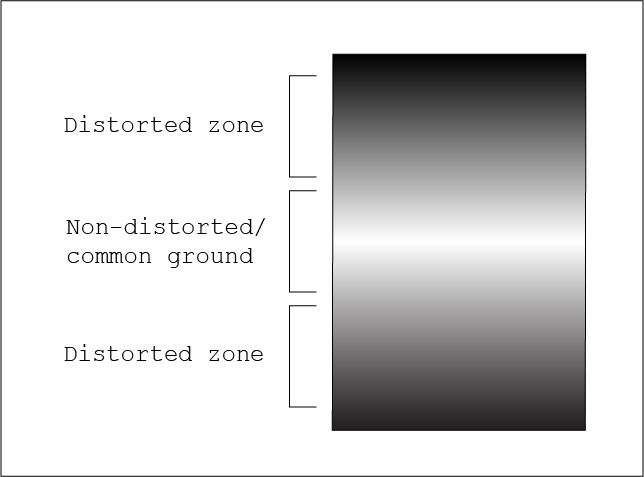
Some forms of distortion I know:
- Both persons believe that the other’s belief is bad
- One person believes that the other’s belief is bad, and the other can’t explain why they believe
- One person sees the other’s vision is unbelievable, and the other cannot prove it satisfactorily
- One person knows that their own behavior is bad, even betrayal, but don’t know how to confess it before too late
- One person knows they demand many contradictory things
- One person knows that their thinking is actually true and can give reason, but don’t know how to deal with the other’s self-esteem and insecurities
- Good arguments of one person are not understandable, so what are left are their bad arguments (negativity bias)
- One person defends themselves by talking on irrelevant things (rationalization)
These things actually are the same, but its exact representation is context-sensitive. Like the heisenbug, its transformative form makes it unable to catch, even though the problem always seems to be there. It can be caused by the lack of a concrete knowledge, the tip of the tongue phenomenon, the non-awareness of automatic thoughts, or the insecurity/anxiety/guilt. These factors shrink the non-distorted zone down.
In those situations, there is no time for cautious and polite. Any attempt to subtly message the feeling will become irrelevant to the listener, and just a single thought to sugarcoating the issue is enough to make the speaker feels unproductive or even passive-aggressive. When one still be worry and has to sugarcoat it, then the other still have a feeling of not being honest. When the effort to reduce one’s insecurity can evoke the insecurity of the other, then it is not just a blind leading a blind, but can become a blind fight.
But if both communicators realize their perspectives are just distorted versions from each other, then the communication will be easier. What is right or wrong will be blurred, and a lot of illusions, biases and blind spots will disappear. It encourages us to speak our feelings, but still protect our self-esteem in case what we voice is dismissed. We don’t have to abandon our perspective, but still be able to explore theirs. Not only we can build a theory of mind towards them, but also help them build a theory of mind towards us.
With a healthy attitude towards communication, both parties can see the benefits to construct it. By seeing the way to get out of the conflict before it even starts, there is no insecurity and therefore no distortion. By knowing that distortion is a natural thing to happen, there is no need to feel anxiety, shameful or guilty when addressing it. By remembering that our perspective can be distorted, the I-message will be used reflexively. Knowing ahead that the other person’s perspective is also distorted, we will be able to plan the conversation and identify the points that one side overlooks.
There are still distortions happen for both sides, but when that happens both can still listen mindfully and be curious for a perspective they don’t know of, instead of feeling frustrated or attacked. The vicious cycle will be converted to a language game, in which both players identify underlying fadednesses and form new clearnesses in both sides. The game is success when at least one player’s perspective is transformed, and they will have a joyful moment together. If everything goes wrong, they just need to take a break and start a new game.
I think all dissatisfactions in interpersonal communication can be solved when both sides understand this fact:
When we expect others to be logicians, they are just memorizers. But when others expect us to be memorizers, we forget.
If we can assume that others are just memorizers, then we can see that they don’t mean to harm us, even though it doesn’t seem so, and thus we can react calmly to that.
The cold gaze
Cueball is thinking about Megan. Their relationship is dysfunctional, and what she has said or done makes him either living in a fantasy or in hell. How can he help himself?
In the new perspective, you are free from your emotion. You don’t have to worry about having fear, bias, heuristics, memory distortions, etc. Your mind is sharp and rational in this perspective.
But how can he get to a new perspective when by definition he is locked in the old one? Let’s say Megan put him into hell, how can he stop the anger when she has no sign to try to fix the situation at all? He has tried everything, but the only thing he sees is her avoidance, prejudice, mockery. The resentments cloud him when he brushes his teeth or eats his breakfast, interrupting his work and draining his energy. Even when he is able to focus for a moment, his mind is quickly exhausted and drifted back to the pains.
It’s so easy for him to let her go, but his little logical naïve realism person doesn’t give up. Letting her go is the easiest thing to do, holding the logic is much harder. A therapist would see him very strange, because the client seems to be totally sane and should have already moved on.
As always, if logic cannot be used to solve the problem, then it’s time to try some imaginations. He needs to see how Megan stops dismissing him but look into his eyes and asks:
What would you do to beat this pain? Because if you can beat it, then I am willing to regret. I’ll help you to revenge me, and I’ll do everything to get your trust back. But first, give me the proof that you are strong.
This is so surprising, but it is all what Cueball longing to hear. She, the one who brings hell to him, demands him to become the best of him. A chain of reactions runs in his mind, making sense of everything he knows about her, allowing him to ask the million dollars question he should have asked a long time ago: “wait, why do I have to suffer from this?”
The first time he experiences it he will see how his fears are cut off his body. That gaze is cold like ice, cuts through his body, as if a surgeon coldly opens him, takes out the cancer that devouring him for years, and sews his skin back. No part of the process shows that the surgeon has a single interest to the patient; all the patient knows is that his private body and mind is examined inside out under the gaze. He has to put his life to the hands of a person who has completely no string attached with him beside getting their work done, yet total trusting is the prerequisite for the operation to be conducted effectively. Under the gaze of the surgeon, the patient is paralyzed and desensitized.
Getting to the other perspective and looking back to ourselves is like standing in front of a mirror and see someone else observing us. The person looking at you must have your absolute respect; they can be the target you have attachment with, your future you, your past you, your innermost you, or an imaginary authority that you voluntarily subordinate the very moment you look at them. Whether you are wholesome or rotten is none of their business, but nevertheless they prefer you to be wholesome. You don’t want to make them disappointed, and you are making them disappointed.
Knowing that we have distortions is one thing, but being able to cut ourselves wide open is strange. Your mind is sharp than ever before, seeing why everything you think is wrong. It points out our secret expectation of having something in return for what we give, and eliminates it. It helps us differentiate between ruminating about the past and developing coping strategy to live in the present. Under your own gaze, you are emotionless and detached to yourself, but still see how you are lovable and protected.
We should speculate what others think, because we are a social, problem-solving and curious species. But doing that before the pain is solved only make our perspective distorted and worsen and prolong it. The healing process only starts when we focus on our core values, and to do that we need to solve our distortions and their distortions at the same time. If we have to assume anything, then assume that they are busy to become a good person. Because the only way to catch the attention of a busy person is to help making their hard work less burdensome.
After seeing how she will not dismiss him, there is still one more step he needs to do: cutting the guilt of not forgiving. It’s time for him to look into her eyes and ask:
What would you say to someone you betrayed? What do you expect in someone you betrayed?
Until she gives a satisfactory answer, then he can finally remain silent even when he feel guilty. It is this ultimate silence that cuts her open wide and awakes her core values. It allows him to observe her crystal clear, and assures that he is not ruthless.
Like the analogy, the cold gaze brings you out of the distortion, gets you to a new perspective so you can look back and find the solution, but this time it mixes with Buddhist detachment and Foucault’s medical gaze.
Comparison to other models
Before going to the discussion section, let’s compare the theory to contemporary ones in various fields.
Cognitive psychology
Depending on the context, the clearness – fadedness continuum can be described as:
| Model | Clearness | Fadedness | Example |
| Attitude | Explicit attitude | Implicit attitude | Belief, judgement, external pressure |
| Persuasion | • Central route processing • Systematic processing | • Peripheral route processing • Heuristic processing | |
| Awareness | Consciousness | Unconsciousness | Judgement, categorization |
| Knowledge | Declarative knowledge | Procedural knowledge | Categorization, feature, attribution, proposition: FADEDNESS(clearness 1, clearness 2) |
| Attention | Controlled process | Automated process | Rumination, absentminded, slip, inattention blindness |
| Memory | Retrievable memory | Decayed memory | Prime, stimuli, tip of the tongue effect, recall, recognition |
| Logic | Stated information | Unstated assumptions |
The movement is the organization of knowledge, or the thing you observe in your self-awareness, retrospection, introspection, metacognition, etc. The perspective can be the schema, script, frame, topic, mindset, mental state, paradigm, worldview, belief, etc.
Memory
Let’s compare to the multi-store model:

| Clearness | Retrievable memory |
| Fadedness | Irretrievable/decayed/forgotten memory, automaticity |
| New clearness registration | Transfer to long-term memory |
| Movement forming a clearness | Chunking, bottom up |
| Looking into a clearness and see a different perspective in there | Memory retrieval, top down |
| Perspective changing make the fadedness becomes clearness | Attention, long-term memory to working memory |
| Movement changing under the same clearness | Memory distortion |
Cognitive linguistics
| Fadedness | Prior knowledge |
| Movement completion registers new clearness | Concept formation |
| Movement reset | Schema change, language fluidity, clear-cut boundary becomes blurry |
| Isolated clearness | Fleeting perfect word combination |
| Unique set of clearnesses | Defining features (necessary and sufficient conditions) |
| Clearness | Fadedness | Perspective | |
| Frame semantic | Element | Frame | |
| Cognitive grammar | Thing | Relation | |
| Metaphor | Feature | Domain |
There are 5 frameworks to study communication: (1) communication as shaper of public opinion; (2) as language use; (3) as information transmission; (4) as developer of relationships; and (5) as definer, interpreter, and critic of culture. Under different perspectives the partakers will have a hard time to communicate efficiently. The perspectives are different, but they are slightly different. The clearness communication, therefore, is a polysemy.
Cognitive therapies
This is the model of CBT (image taken from Hofmann, 2012):
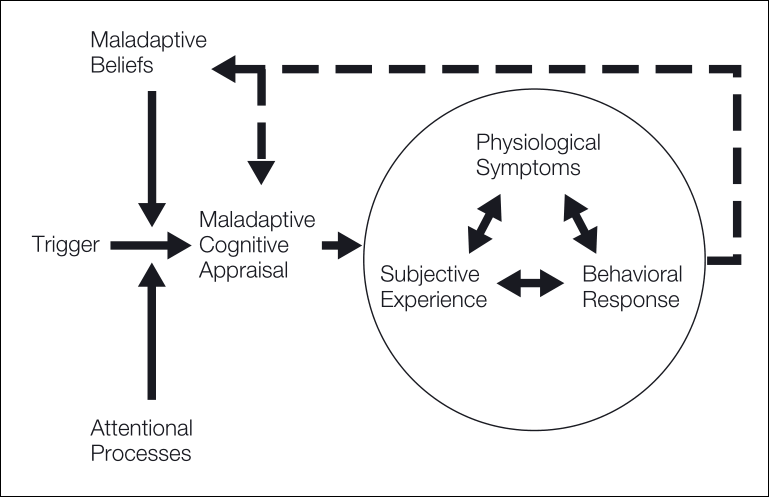
| Core belief, maladaptive cognition, misconception, impulse | Clearness |
| Automatic thought, maladaptive cognition, misconception | Fadedness |
| Identifying misconception, downward arrow technique, acceptance | Unfading a fadedness (by changing the perspective) |
| Modifying misconception | Resetting the movement |
| Acceptance, exposure | Getting into a new perspective |
| Distancing, decentering | Getting to a new perspective and looking back |
Buddhism
| Clearness | Dharma |
| Duality | Dharma is both real and unreal, impermanence |
| Movement forming clearness | Conditions produce dharma |
| Perspective | Clinging on dharma |
| Mindfulness | Being attentive of the duality of each clearness |
| Enlightenment | Movement forming and clearness registration |
| Detachment, dispassion | Getting to a new perspective and looking back |
| Reincarnation, impermanence | Chain of clearnesses |
Discussions
This theory came up before I read about all of these models, therefore it’s really naïve. All I want is to see how far an analogy can go.
I have no idea what a “look” mean, and I can’t explain where emotions come from. I’m not sure if this theory is falsifiable or not, and I don’t know how to conduct experiments on it. Therefore my hope is to present as many perspectives as possible on the word “perspective”, and if everything turns out to be wrong, then I hope you have had a new perspective.
If the ability to change attitude and put yourself into other’s shoe simply depend on the exact combination of words and nothing else, then we can hope for the peace of the world. It is quite romantic, but it has a foundation in cognitive linguistics and social psychology. There are cognitive sociolinguistics and cognitive social psychology, but what I’m looking for is the application of memory and cognitive linguistics in social psychology. Really, you can change others’ attitudes if you can find a polysemy from their accepting zone, and you can stop thinking about the past if you can add a new layer of meaning to the preexisting word.
If everything is just a language game, then we will have the ultimate optimism to deal with any unfortunate in life. Just beware of the optimism bias and planning fallacy and all are good. By being able to transform our perspective, our language will be straightforward, our mind will be fearless, and our action will be spontaneous. If both sides can see each other’s perspective, then our words is meaningful to the other, their mind will be mindful to listen, and the conversation will be joyful.
Here is the table of related fields and areas to this project:
| Fields… | …I moderately understand or know superficially | …I should have read |
| Philosophy | Taoism, postmodernism, epistemology, romanticism | Logic, metaphysics, phenomenology, ontology, philosophy of mind, philosophy of language, perspectivism |
| Psychology | Cognitive psychology, analogy, CBT, mindfulness, social psychology, borderline personality disorder, emotion, betrayal, mathematical psychology (Narens’ theory) | Personality psychology, educational psychology, humanistic, philosophy of psychology |
| Linguistics | Cognitive linguistics, stylistics, semantics, syntax | Lexical semantics, pragmatics, semiotics, cognitive social linguistics, discourse analysis, document analysis, corpus analysis, lexicography |
| Communication & cultural studies | Communication study, interpersonal communication, negotiation, rhetoric & composition, Chinese rhetoric, poetics, mysticism | Sociology, paremiology, design & typography, decision analysis, pedagogy |
| Math & hard sciences | Projective geometry, group & representation, dynamical systems, harmonic analysis, complex analysis, history of math | Information theory, neurosciences, AI, relativity theory |
Connect to other fields
Information/metaphysics/epistemology/neurocognition
In the eyes of a theoretical physicist, the world is full of oscillators. To quote Sidney Coleman: “The career of a young theoretical physicist consists of treating the harmonic oscillator in ever-increasing levels of abstraction.” Because the derivative of amplitude is velocity, so when the velocity is at 0, the amplitude reaches its peaks. So maybe the clearnesses are the maximums and minimums of abstract oscillators?
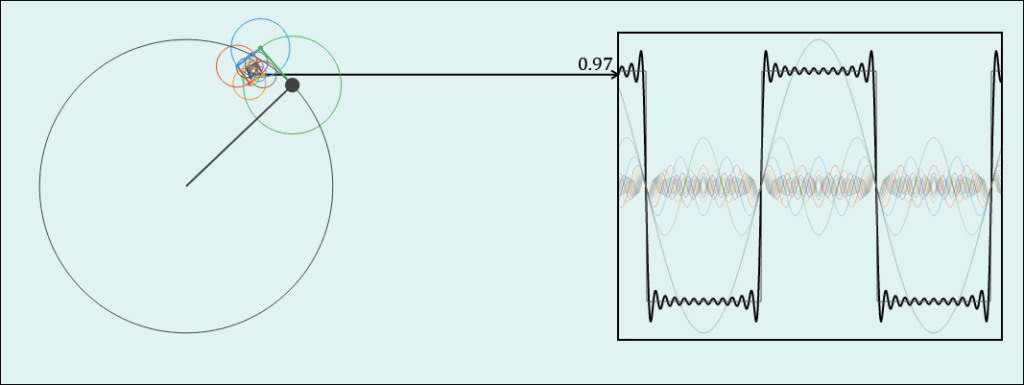
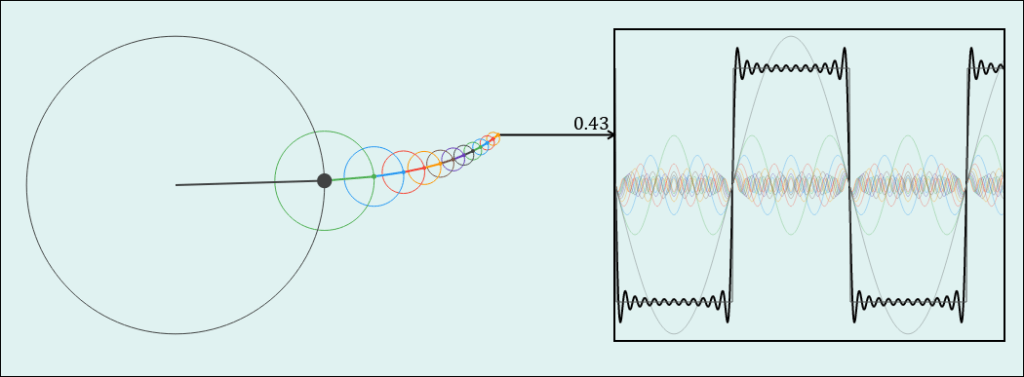
For a cook to not be deceived by the brown burnished look of a roasted chicken, they must insert a probe thermometer to check the temperature. Assuming that every time the temperature reaches 160°C the probe will beep for one second, then philosophically speaking it is a kind of Chinese room. What we see in the probe is different to what the probe sees the world.
But fundamentally the way we see it is not different to the way it sees the world: both are just chains of resonances between internal and external oscillators. Because what we see in it is different to what it sees the world, the input oscillations of the probe is different to the oscillations it outputs. In other words, for our ears to be able to hear the temperature of the chicken, the perspective has to be changed significantly. Via the probe, the perspective has changed significantly.
For whatever phenomenon happens in the world, if it can be understood by our brains, then there should be a physical property that exists in both the brain and the phenomenon, regardless whether it is a quantum or galactic event. I think that property can be the Fourier transform. If that’s the case, then is the brain just a box to register new oscillators from the environment? Brain wave or electrophysiology is Fourier transform no dispute, but I’m talking at the cognitive level.
If we can find the mathematic of all cognitive processes (assuming here that it’s Fourier transform), then what is the nature of other mathematics branches? Does that mean in any branch we must use Fourier transform to process it? Would that be a reason why harmonic analysis plays an important role in modern math? If we say that atoms share a mathematic model to solar system, would that mean the mapping between perspectives is really a kind of homomorphism?
Anecdotally, only after “realizing” that information is just resonance of oscillators that I could act spontaneously and improvisingly, and get out of the analysis paralysis or naïve realism.
Cognitive semantics
The angle the probe is inserted can affect whether it can detect the temperature is 160°C or not, making what it actually sees slightly different to what it should see. When the perspective is not significantly different, ambiguity will arise, and this is what I’ll call generalized polysemy.
Before returning to polysemy, let’s talk a little bit about negation. Despite the fact that contradictory brings cognitive dissonance, and negation isn’t handled as effectively as other logical operations in the brain, it seems that double negation brings a sense of concreteness. For example, take a look of my most memorable definition:
A representation U(G) on V is irreducible if there is no non-trivial invariant subspace V with respect to U(G).
I really couldn’t pass this definition until realizing that there are four negations hidden in various places and various forms: ir-, no, non-, in-. Logically, they can be canceled out, but perhaps linguistically and cognitively, they are very concrete. To understand it, I imagine a flow of meaning being pushed to one side and pushed back, and the elements of the space are pulled from one place to another, four times in total. The experience of it is so… unforgettable, and because the expert can’t forget it they cannot realize that the concept can be explained in a simpler way by canceling the negations.
A bat is not a bat, and a bank is not a bank. Through negation, the ambiguity of polysemy can be cleared out, allowing a different meaning to take place from a previous one. Without this, syntheses cannot become theses, efforts to become adaptive cannot become maladaptive, action cannot be done from doing nothing, and the funny irritating epistemological question cannot be asked: you say this is a hamburger, but is it really a hamburger?
I think the concept of wuwei (doing everything by doing nothing) in Taoism is built on the combination of polysemy and negation, and one has to master the art of double negation to understand the teaching. The double negation creates two sudden switches, swinging the meaning back and forth, and this is where yin-yang stems from. I think double negation is more concrete than affirmative because with it misunderstandings can be cut down sharply, and in a sense it’s not different to going into another perspective to gaze on yourself to eliminate distortions.
Appendix 1: The analogies
The first analogy is the pendulum, which is commonly used in Zen or Taoism. The extremes it swings back and forth represent the duality/dichotomy/polarization of the phenomena (me – you, good – bad, right – wrong), and the balance point is somewhere in the middle.

The visual effect of the pendulum comes from its velocity. The pendulum goes fastest at its balance point, and has zero velocity at the extremes. Therefore it can be seen wholly for a moment, before it gets fader to the balance point. The higher velocity the pendulum is, the clearer the extremes and fader the trajectory are. If it goes fast and far enough, the trajectory may completely faded, resulting two seemingly unrelated clear images.
In general, the trajectory of an object that constantly changing its velocity would go from clearness to fadedness:

The second analogy is the moon. It’s not just a symbol of purity or solitude, but also where all the chaos of the world makes sense again. The chaos is the source of all of the sufferings and happiness; transforms what we know unpredictably, brings the familiar to infinity, and the unfamiliar close to us.
I cannot help to realize this is the Riemann sphere:
In mathematics, the Riemann sphere is used to describe the transformation of perspectives. The notion of transformation is important, because it shifts us from the mindset that different perspectives are intrinsically different, to the mindset that they are just distorted versions of each other, and can be transformed back and forth if we know the rule.
In practice, it is easier to imagine how distortion happens under different perspectives with anamorphosis art:
Basically the distortion tells us that although all perspectives are born equal, some of them are more equal than others.
Appendix 2: Other thoughts
1
There are three mathematical branches that are used in this theory: projective geometry, dynamical systems, and maybe harmonics analysis. As far as I know, the only theory in physics that links all of them is… Einstein’s relativity theory. I’m speechless 😶
But I think the mathematical model is totally different and should not be that overkill. As I found the Riemann sphere via the pendulum solution, I don’t think it involves the spacetime curvature or light velocity. At best it may involve the Galilean group.
Although it would be great to find the energy flux of the movement, in essence, this section is no different than saying the universe must have a designer because the watch has one.
2
How could Thich Quang Duc tolerate the pain to remain calm during his self-immolation? High cortisol level can numb significant pain, but I’m not convinced that he was just calm at the surface but was fighting with the burn inside.
Long-term meditators is known to be able to activate gamma wave on-demand to go in unconsciousness and having dissociation to the outside world (Koch, 2013). Perhaps meditation is a way to master embodied oscillators without the need of conceptualization? It’s possible I think, but it’s really hard. Can AI do the same?
3
So can we have the theory of everything?
I… really don’t know. But let’s assume that we just find it out today, and tonight we are going to have the largest party ever. WE KNOW EVERYTHING!
What would happen after a couple months? Do we still believe in it psychologically? Sure, the experiments will always confirm the theory, but since the nature of science is to doubt what you believe in, I think we always find new perspectives to explore. Would we stop finding new perspective?
The theory of everything would dictate how we understand it. How would it present itself to a kid? If it can explain the small-world network, can it be explained by introducing 6 new terms only? Can we know whether a cat know it too? Can it help us less afraid of sitting on a fire? I think, if we are serious to find the theory of everything, then we should also be serious to explain it to a kid.

Bibliography
Philosophy
Appignanesi, R., C. Garratt, Z. Sardar, and P. Curry, Postmodernism for Beginners, Beginners Series (Totem Books, 1995)
Fillingham, L.A., and M. Süsser, Foucault for Beginners, Riters and Readers Documentary Comic Books (Writers and Readers Pub., 1993)
Jullien, F., The Propensity of Things: Toward a History of Efficacy in China, trans. by Lê Đức Quang (Danang Publisher, 2004)
Laozi, Daodejing
Linguistics
Martin Hilpert, A Course in Cognitive Linguistics: Categorization <https://www.youtube.com/playlist?list=PLKgdsSsfw-faeun9_0LVETPT-ZGpKptlj> [accessed 18 October 2018]
Pinker, S., The Sense of Style: The Thinking Person’s Guide to Writing in the 21st Century (Penguin Publishing Group, 2014)
Yip, P., The Chinese Lexicon: A Comprehensive Survey, Chinese Language / Linguistics / Reference (Routledge, 2007)
Psychology
Bordens, K.S., and I.A. Horowitz, Social Psychology (Taylor & Francis, 2013)
Gentner, D., K.J. Holyoak, K.J. Holyoak, and B.N. Kokinov, The Analogical Mind: Perspectives from Cognitive Science, Bradford Books (MIT Press, 2001)
Germer, C.K., R.D. Siegel, and P.R. Fulton, Mindfulness and Psychotherapy (Guilford Publications, 2005)
Hofmann, S.G., An Introduction to Modern CBT: Psychological Solutions to Mental Health Problems (Wiley, 2011)
‘How to Be Taken Seriously by Those Who Fail to Consider Your Input’, Kletische, 2018 <https://kletische.com/taken-seriously-input/> [accessed 20 December 2018]
‘How to Get Someone to Try New Things’, Kletische, 2018 <https://kletische.com/get-someone-try-new-things/> [accessed 20 December 2018]
Koch, Christof, ‘The Brain of Buddha’, Scientific American Mind, 2013
Kreisman, J.J., and H. Straus, I Hate You, Don’t Leave Me: Understanding the Borderline Personality, HarperCollins Publishers (Avon Books, 1991)
Schacter, D.L., Forgotten Ideas, Neglected Pioneers: Richard Semon and the Story of Memory, Critical Social Thought (Taylor & Francis, 2012)
Sternberg, R.J., and K. Sternberg, Cognitive Psychology (W. Ross MacDonald School Resource Services Library, 2011)
Stosny, S., Living and Loving after Betrayal: How to Heal from Emotional Abuse, Deceit, Infidelity, and Chronic Resentment (New Harbinger Publications, 2013)
Strongman, K.T., The Psychology of Emotion: From Everyday Life to Theory (Wiley, 2003)
Communication
Cobley, P., and P.J. Schulz, Theories and Models of Communication, Handbooks of Communication Science [HoCS] (De Gruyter, 2013)
Wood, J.T., Interpersonal Communication: Everyday Encounters, Mindtap Course List (Cengage Learning, 2014)
Math & hard sciences
Arnold, Douglas, and Jonathan Rogness, Mobius Transform Revealed <https://www.youtube.com/watch?v=JX3VmDgiFnY>
Dunning, Mike, Pendulum <https://www.wired.com/2016/10/modeling-pendulum-harder-think/>
French, A.P., Vibrations and Waves, M.I.T. Introductory Physics Series (Norton, 1971)
Hurwitz, Jonty, Tribute To Holbein
Mitchell, M., Complexity: A Guided Tour (Oxford University Press, 2009)
Needham, T., Visual Complex Analysis (Clarendon Press, 1998)
Segerman, Henry, Octahedron (Stereographic Projection) <https://www.shapeways.com/product/NE544EP3J/octahedron-stereographic-projection?optionId=18075775>
Stillwell, J., Mathematics and Its History, Undergraduate Texts in Mathematics (Springer New York, 2004)
Tung, W.K., Group Theory in Physics (World Scientific, 1985)
Other
Nguyễn Băng Ngọc, Dấu Vết Thiên Di (Trace of Migration)


Leave a Reply